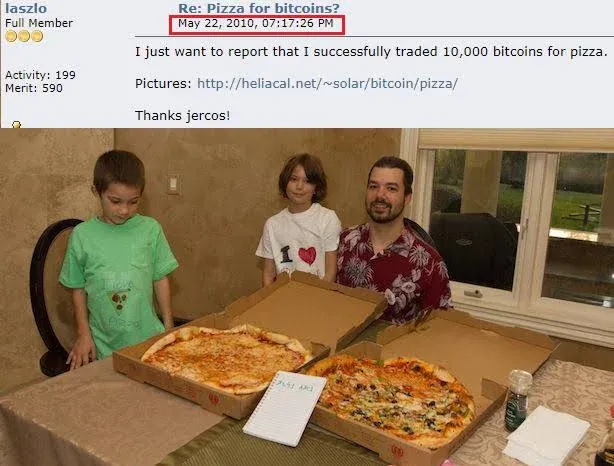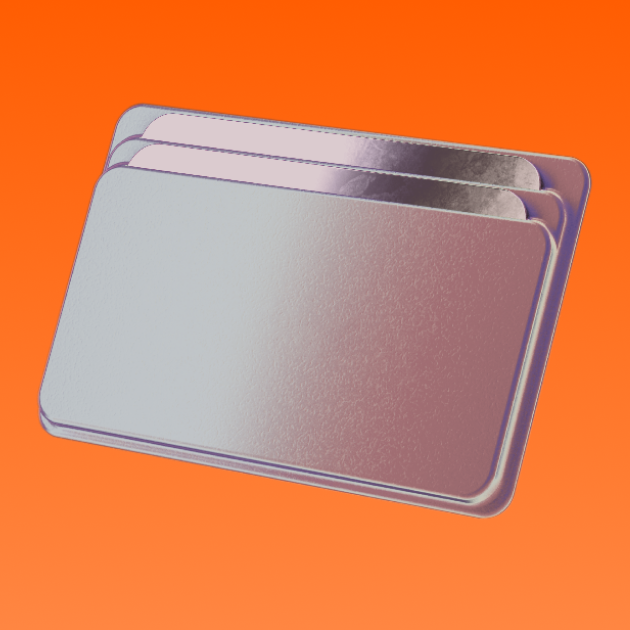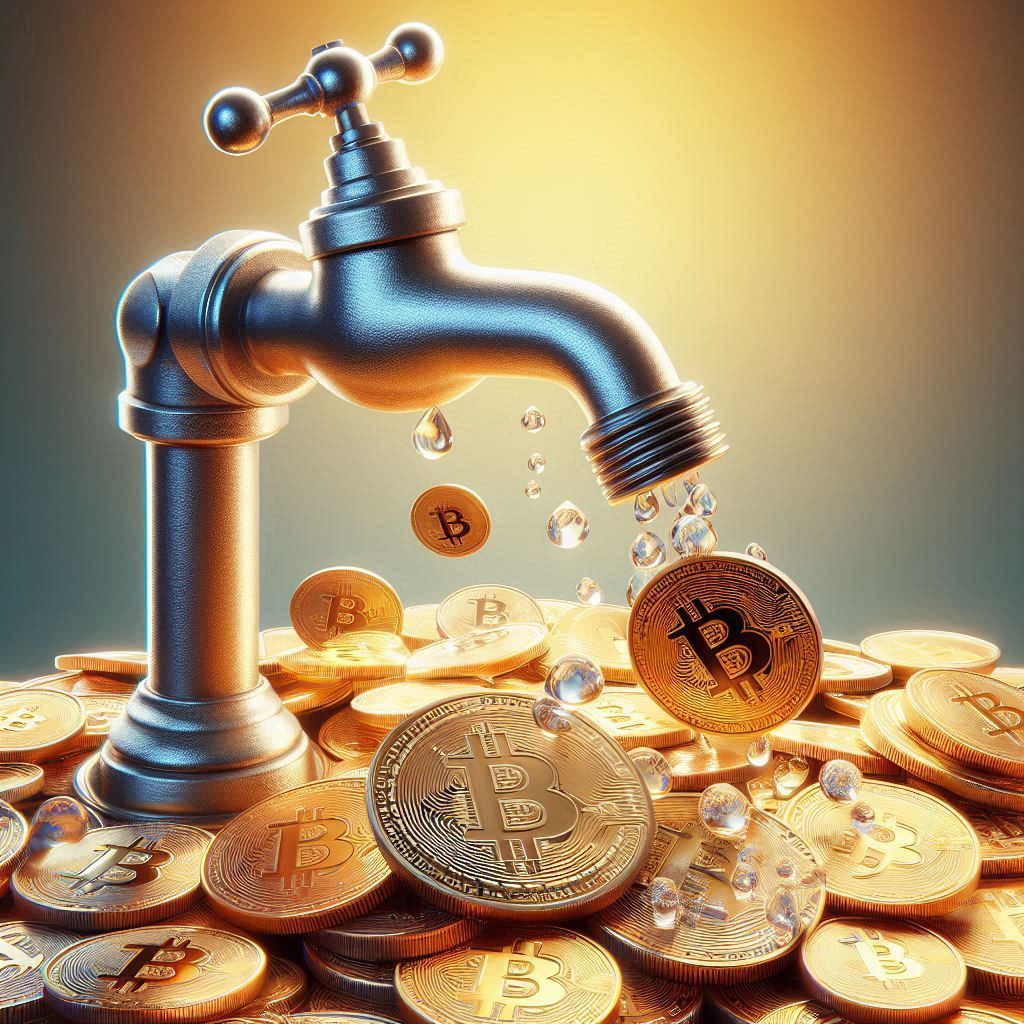Bitcoin Pizza Day: Commemorating the $1B Pizza Order
Step into the kitchen and learn the history of Bitcoin Pizza Day—the first real-world BTC transaction—and how it sparked today's crypto revolution.
By Corey Barchat
.png)
Today, you can virtually anything with cryptocurrency. Participating merchants will offer their goods and services in exchange for tokens like Bitcoin. With its market cap in the trillions, Bitcoin (BTC) is becoming a more viable alternative to fiat currency, and is even seen as more desirable than fiat in certain countries.
But paying with crypto wasn't always so convenient or accessible.
Back in 2010, software developer Laszlo Hanyecz paid 10,000 BTC for two pizzas in the first known real-world transaction using Bitcoin
Though seemingly innocuous—and quite expensive in today's terms—this simple act represented a fundamental shift in how Bitcoin was perceived. Prior to the transaction, Bitcoin had no established monetary value and had never been publicly used to purchase tangible goods or services.
And now, every year on May 22, the global crypto community commemorates this pivotal milestone in Bitcoin’s history—Bitcoin Pizza Day.
But how did Bitcoin Pizza day happen, and what is the significance of this historic event in the timeline of blockchain technology?
Bitcoin Before Pizza Day
To fully understand the importance of this moment, we have to rewind to what Bitcoin was like before Pizza Day.
On January 3, 2009, the first BTC block was mined by Satoshi Nakamoto. The network was small, its users were mostly niche cryptography geeks, and there was little value yet attached to a “bitcoin.”
In those days, BTC was mined on home computers using CPUs without GPU cards or fancy mining equipment. Transactions were limited to test sends between developers, and people gave away thousands of bitcoins just for fun or for testing code.
No one could really know if the concept of decentralized, peer-to-peer money would actually work. The only things keeping Bitcoin alive were curiosity and idealism among a small group of believers.
Forums like Bitcointalk.org became the epicenter of Bitcoin conversation (as we'll see below), and even that hub had its share of doubters who weren’t sure the project would catch on. There weren't any crypto exchanges up and running, just informal trading and in-person swaps.
Bitcoin existed more as a theoretical alternative to fiat than a usable currency. That’s what makes Pizza Day such a big deal. It was the first time someone said, “I will give you Bitcoin if you give me food,” and it actually worked.
Laszlo Hanyecz and the 10,000 BTC Pizza
Enter Laszlo Hanyecz, a programmer based in Jacksonville, Florida. Hanyecz had been contributing to Bitcoin’s early development, and was even on Satoshi's original dev team. He was also one of the first to experiment with GPU mining, which helped him accumulate thousands of BTC when they possessed little to no value.
In his book Digital Gold, author Nathaniel Popper shares that Hanyecz was winning up to blocks of 50 bitcoins per day and multiple blocks per hour using his experimental methods. Legend has it that Hanyecz even explained his breakthrough to Satoshi Nakamoto via email.
To this, Satoshi replied back expressing his hesitation that such mining techniques could eventually cause an unfair playing field, with too many coins concentrated in the hands of a few lucky miners—an issue that is still prevalent in Bitcoin mining to this day.
On May 18, 2010, Laszlo made a post on Bitcointalk offering 10,000 BTC for two large pizzas. He wasn’t even looking for the best offer, but rather just someone to accept BTC in return for something real.
“I’ll pay 10,000 bitcoins for a couple of pizzas like maybe two large ones so I have some left over for the next day. I like having left over pizza to nibble on later,” he wrote.
At the time, those 10,000 BTC were worth roughly $41 based on early exchange rates. But this was really just a fuzzy estimate, as there was no real BTC price discovery yet—as shown by the bartering being done on the forum itself. Today, those same coins would have been worth hundreds of millions of dollars—exceeding even $1 billion between December 2024 and February 2025—making it the most expensive pizza order in history.

But Laszlo wasn’t concerned about mere price or value. He cared about proving utility. And that’s exactly what he did.
The Bitcoin Pizza Agreement: How the Deal Went Down
The offer sat on the forum for a few days, with many users unsure whether someone would actually go through with it. Some thought it was a joke, others said it was too early for such trading, and a few even warned Laszlo not to “waste” his BTC on pizza.
After a few days without receiving a bite on his offer, Hanyecz posted again, wondering if his listed price of 10,000 BTC was too low. One user based outside the US did express interest in the deal, though they didn't have the means to complete the pizza order from their home location.
But then, on May 22, a user named Jeremy Sturdivant (handle: “Jercos”) replied on a different forum and agreed to make the trade. He was only 19 years old at the time and saw it as a fun experiment. He ordered two Papa John’s pizzas for Laszlo—one cheese and one supreme, without the "weird fish" toppings per Laszlo's instructions—and had the food delivered to his home.
In return, Laszlo transferred 10,000 BTC to Jeremy’s wallet. The transaction happened completely online. No banks, no credit cards, no PayPal. Just two people using the internet and trusting a protocol that was barely over a year old.

Laszlo later posted photos of his children and himself enjoying the pizzas, documenting the first time Bitcoin was used to purchase of real-world goods. Through this, he also etched himself and the date of May 22 into blockchain lore forever.
What did Jeremy Sturdivant do with the 10,000 bitcoins?
You might think Jeremy became a crypto whale millionaire—or billionaire—off that pizza trade. But that’s not what happened. Like some early Bitcoiners, he saw BTC as a cool project, rather than a long-term investment.
Jeremy spent most of the 10,000 BTC over the next few months. He later said he didn't regret it because, at the time, there was no reason to believe Bitcoin would become what it is today. "I would never have thought that the same number of bitcoin would have a purchasing power on the order of real estate," Sturdivant said.

If he had decided to HODL, Sturdivant says that he would've used the money on a road trip with his girlfriend. But with the buying power of 10,000 bitcoins, he could've purchased an entire fleet of luxury sports cars, rather than spending it on a single road trip.
And while he didn’t hold onto the BTC, Jeremy still became a minor legend in the crypto world for his role in validating Bitcoin’s value. Without someone willing to accept BTC in exchange for something tangible, the idea of Bitcoin-as-money may have taken much longer to take root. Says Hanyecz of the exchange, “I’d like to think that what I did helped. But I think if it wasn’t me, somebody else would have come along.”
Fun Facts About Bitcoin Pizza Day
- 📜 The original transaction is recorded on the blockchain forever, in Block Height 57,043.
- 💸 Laszlo kept buying pizzas with Bitcoin and spent over 100,000 BTC on similar purchases that summer.
- 😱 His total expenses would've cost over $10 billion at Bitcoin's height in 2025.
- 🎉 May 22 is now a global celebration in the cryptocurrency space, commemorated by users and companies alike, with memes, merch, and tributes.
- 😅 Laszlo has said he doesn’t regret it, since he helped spark Bitcoin’s utility.
- 🤝 Jeremy doesn't regret spending his 10,000 BTC pizza winnings either.
- 🍕 The Bitcoin Pizza Index measures how much these pizzas would be worth today (over $1 billion at its ATH in 2024).
- 🤑 You could buy over 50 million pizzas today with 10,000 bitcoins.
- 💰 Those two pizzas today would be worth just 0.00044 BTC.
- 📈 Bitcoin Price Checkpoint: Each Pizza Day is a yearly reflection point for Bitcoin’s value.
Check out the table below to see BTC's price over the last 15 years on May 22—and how much those two pizzas would've cost him.
Day | Year | BTC Price (USD) | Price paid for Laszlo's two pizzas |
May 22 | 2010 | ~$0.0041 | $41 |
May 22 | 2011 | $6.12 | $61,200 |
May 22 | 2012 | $5.10 | $51,000 |
May 22 | 2013 | $123.89 | $1,238,900 |
May 22 | 2014 | $524.58 | $5,245,800 |
May 22 | 2015 | $240.97 | $2,409,700 |
May 22 | 2016 | $439.32 | $4,393,200 |
May 22 | 2017 | $2,173.40 | $21,734,000 |
May 22 | 2018 | $8,041.78 | $80,417,800 |
May 22 | 2019 | $7,680.07 | $76,800,700 |
May 22 | 2020 | $9,182.58 | $91,825,800 |
May 22 | 2021 | $37,536.63 | $375,366,300 |
May 22 | 2022 | $30,323.72 | $303,237,200 |
May 22 | 2023 | $26,851.28 | $268,512,800 |
May 22 | 2024 | $69,122.34 | $691,223,400 |
May 22 | 2025 | TBD | TBD |
Why Bitcoin Pizza Day is Important
Bitcoin Pizza Day is more than just a meme. It represents the moment when Bitcoin transitioned from a theoretical system into a usable form of digital money. That simple pizza transaction proved a fundamental point: Bitcoin could be exchanged for real goods, peer-to-peer, without intermediaries.
Key Lessons from BTC Pizza Day
- Early adoption comes with risk: Many early adopters couldn't know for sure if Bitcoin would last, but their participation made the system viable.
- Evolving perception of value: What was once seen as geek currency is now traded by Wall Street and held by billionaires, companies, and entire nations.
- Utility drives adoption: Bitcoin needed to be used, not just mined and traded, to reach its full potential for everyday relevance.
How Bitcoin Pizza Day Is Celebrated
Today, Bitcoin Pizza Day is commemorated with events, memes, and, of course, pizza. Crypto companies often join the fun with special promos: discounted or free pizza for using their platform, limited-edition NFTs, free crypto, and pizza-themed dApps (decentralized applications) and games.
Companies have hosted gatherings in cities around the world like Rome, Naples, Rio de Janeiro, and Miami for crypto-natives and newbies alike to share slices and stories. There are also hubs like Pizza.Day that provide resources to help commemorate the day at home, online, or create/find an in-person event near you.

In an industry often focused on price charts, Pizza Day is about culture, community, and remembering why Bitcoin started in the first place.
unknown nodeOther Historic Firsts in Bitcoin’s History
Bitcoin Pizza Day isn’t the only “first” that helped BTC evolve. Some other notable milestones include:
- First Bitcoin exchange: BitcoinMarket.com, March 2010
- $1M market cap milestone: November 2010
- BTC hits $1: February 2011
- $1B market cap milestone: March 2013
- First ETF approval: January 2024
- BTC hits $100K: December 2024
Buy Bitcoin (and pizza) today
Want to pay for your own pizza using cryptocurrency like Bitcoin? With MoonPay, you can—for a lot less than 10 thousand tokens.
MoonPay allows you to buy BTC instantly and send it to any wallet in minutes. Just enter your wallet address and choose from supported payment methods like credit/debit cards, Apple Pay, Google Pay, PayPal, and more.

.png)




